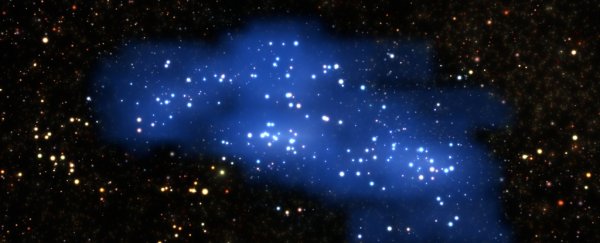There's a lot of stuff out there in the dark, far-flung reaches of the early Universe that we're only just starting to discover. But this one's a real doozy - the early formation of a huge supercluster of galaxies, located 11 billion light-years away - just 2.3 billion years after the Big Bang.
It's the largest and most massive structure found so early in the Universe, with a mass equivalent to the largest structures found in the Universe today. The evidence suggests it's more massive than one million billion Suns.
Astronomers have nicknamed the behemoth Hyperion, after one of the twelve Titans born to the gods Uranus and Gaia.
"This is the first time that such a large structure has been identified at such a high redshift, just over 2 billion years after the Big Bang," said astronomer Olga Cucciati of the Osservatorio di Astrofisica e Scienza dello Spazio di Bologna in Italy.
"Normally these kinds of structures are known at lower redshifts, which means when the Universe has had much more time to evolve and construct such huge things. It was a surprise to see something this evolved when the Universe was relatively young!"
While estimates put the number of superclusters in the visible Universe at over 10 million, none have been spotted even half as far as Hyperion. It was only earlier this year that the discovery of the most distant supercluster to that date was announced - at a distance of 4 billion light-years away.
Cucciati and her team located the Hyperion proto-supercluster, or supercluster in the process of forming, in the equatorial constellation of Sextans, using data from the Hubble Space Telescope's VIMOS Ultra Deep-field Survey.
Combining this data with redshift data from the zCosmos survey, the team were able to define the 3-dimensional volume of the structure, and study its intricacies.
Hyperion, they discovered, is rather complex. It's similar in size to superclusters closer to Earth (our home supercluster, Virgo, is thought to contain over 47,000 galaxies), although its structure is a bit different. It contains at least seven density peaks, or denser regions, but these are connected by filaments of galaxies.
"Superclusters closer to Earth tend to [have] a much more concentrated distribution of mass with clear structural features," said astronomer Brian Lemaux of the University of California, Davis.
"But in Hyperion, the mass is distributed much more uniformly in a series of connected blobs, populated by loose associations of galaxies."
The difference, the team hypothesise, is that superclusters closer to us have had more time to, well, pull themselves together, so to speak - to more tightly gravitationally bind their galaxies into discrete clumps.
The difference helps us understand supercluster evolution - gradually, over the course of billions of years, Hyperion will likely arrange itself into a similar structure.
"Understanding Hyperion and how it compares to similar recent structures can give insights into how the Universe developed in the past and will evolve into the future, and allows us the opportunity to challenge some models of supercluster formation," Cucciati said.
"Unearthing this cosmic titan helps uncover the history of these large-scale structures."
The team's research will appear in the journal Astronomy & Astrophysics, and can be read on pre-print resource arXiv.
